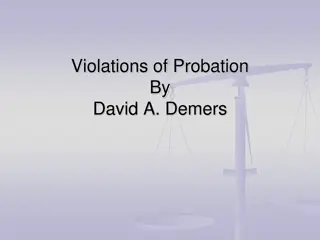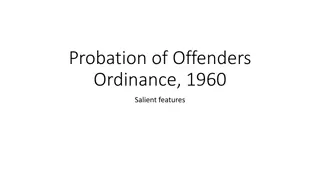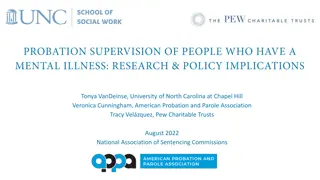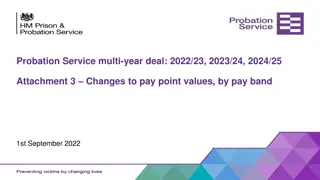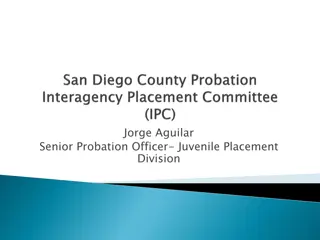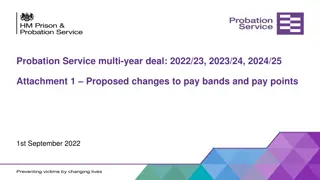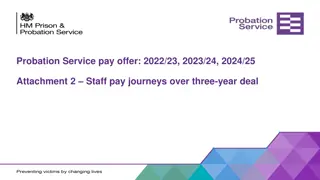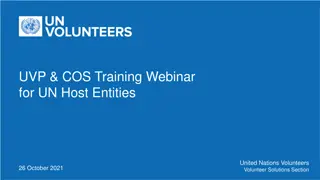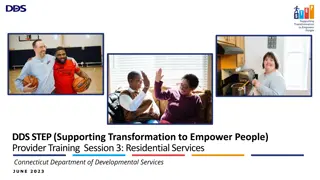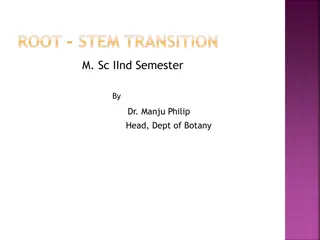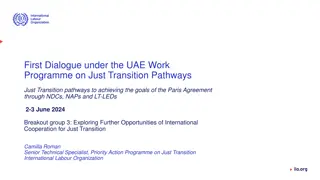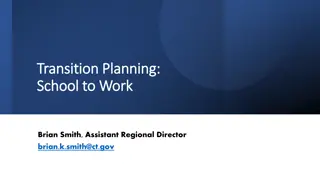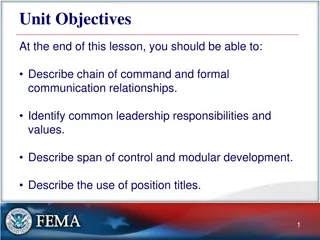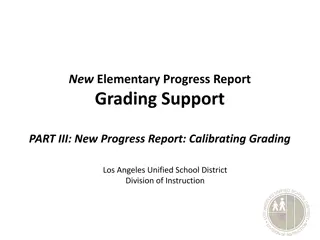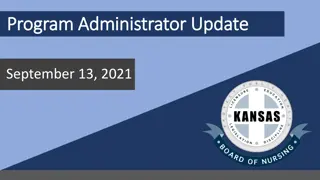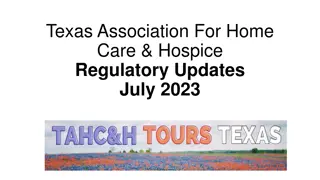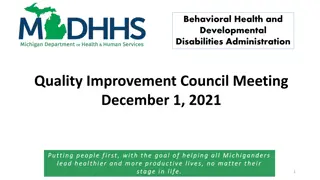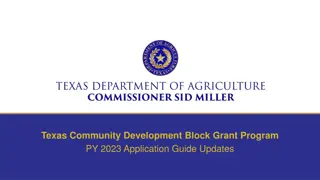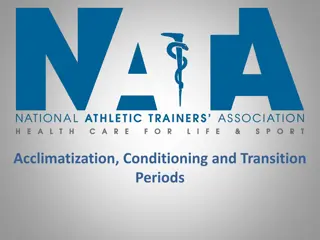Transition to a Unified Probation Service: Key Updates and Challenges
The offender management conference 2021 addressed the implementation of a new unified probation service, highlighting changes due to COVID-19, transition challenges, and risks of harm management. The shift towards a new probation operating model aims for full transition between June and September 2021, emphasizing staff placement and risk mitigation strategies.
Download Presentation

Please find below an Image/Link to download the presentation.
The content on the website is provided AS IS for your information and personal use only. It may not be sold, licensed, or shared on other websites without obtaining consent from the author. Download presentation by click this link. If you encounter any issues during the download, it is possible that the publisher has removed the file from their server.
E N D
Presentation Transcript
OFFENDER MANAGEMENT CONFERENCE 2021 JUSTIN RUSSELL, CHIEF INSPECTOR OF JUSTIN RUSSELL, CHIEF INSPECTOR OF PROBATION PROBATION
PROBATION SERVICES AND COVID-19 Courts General New forms of contact Significant reduction in court reports and new community orders from March June. Exceptional Delivery Model (EDM) implemented. Face-to-face supervision of TACT, newly-released and homeless only. Unpaid work suspended. Court staff working from home. 80% - 90% got phone supervision. New accredited programmes stopped. Virtual links with courts commenced. No home visits, doorstep checks only.
The initial response to Covid-19 A necessary focus on risk and wellbeing, but a need to ensure that reviews of risk of harm work are comprehensive. Delivery of interventions was difficult but quality of risk assessment and planning remained good. Virtual MAPPA, MARAC etc meetings working well multi-agency arrangements strengthened during first lockdown. Remote supervision worked best for stable service-users, but less well for vulnerable/isolated ones.
Too often, I spend too long thinking about whether I should give someone a warning. It takes two minutes in an office, but when I m at home I ruminate and over-think things. Managing risk of harm over the telephone during remote reporting has been tricky, as I feel I can tell a lot from someone s presentation. I think I have a good balance now between a couple of days in the office and the rest of the time at home. Due to being in the office one day a week, office days are usually manic, and it can be quite stressful.
A NEW UNIFIED PROBATION SERVICE FROM JUNE 2021 Transition was well managed at national and regional level and has been generally supported by NPS and CRC staff. 8,500 staff, 97 buildings and almost 113,000 cases successfully transferred into the unified service from the private sector at the end of June. 110 separate contracts were also let with external providers of accommodation, employment and personal wellbeing support and for specialist services for women. But Staffing remains a major concern and unification has confirmed and further exposed the significant differences between the caseloads of legacy CRC staff and those coming from an NPS background. New resettlement arrangements will need careful watching. Enhanced Through the Gate teams have been disbanded, replaced by new rehabilitative services contracts on top of implementation of Offender Management in Custody (OMiC) model. 117 prisons need to link to 108 local probation delivery areas.
TIMESCALE FOR FULL TRANSITION TO NEW PROBATION OPERATING MODEL June to September 2021 transition to a unified structure a lift and shift approach to minimise risks staff placement into roles in the new structure Sept to December 2021 service stabilisation staff placements to be confirmed probation practitioners start to move to a blended caseload Jan to March 2022 harmonisation Case processes harmonised. Move to mixed caseloads completed April 2022 to April 2024 Digital transformation Workforce up to full strength Regional commissioning of support services; strong local partnerships
Management of risk remains a concern (% of cases which were satisfactory on these quality standards) 100% Engagement Desistance Risk of Harm 80% 73% 68% 67% 65% 63% 63% 63% 60% 53% 52% 47% 45% 44% 40% 20% 0% Assessment Planning Delivery Reviewing
A particular issue for low and medium risk cases NPS high risk of serious harm NPS medium risk of serious harm CRC medium risk of serious harm CRC low risk of serious harm Does assessment focus sufficiently on keeping people safe? Does planning focus sufficiently on keeping people safe? Does the implementation and delivery of services effectively support the safety of other people? Does reviewing focus sufficiently on keeping other people safe? 78% 73% 57% 55% 73% 68% 51% 12% 68% 63% 44% 22% 64% 60% 47% 38%
ACCOMMODATION KEY FINDINGS 11,500 occasions in 2018/19 when someone was released from prison homeless and over 4,700 people started a community sentence homeless. 22% of the NPS caseload, by definition the riskiest people on probation, were being released without stable accommodation. Recall rate for prisoners released without stable accommodation was 63% vs 35% for those with secure housing. People come out of jail and commit crime to go back to jail cause they feel safer in jail. . IIt s easier inside than outside I was begging them not to put me back out on the street, but they said if I didn t leave the cell I would be forcefully removed. They kept recalling me for seven years because I kept reoffending to get put back inside as I couldn t get accommodation. Probation can t help us with housing I only go there to stop being recalled, not for help.
KEY THEMES At the beginning of 2020 there was no national, cross-government approach to addressing the huge and growing accommodation needs of people on probation. Many barriers to ex-offenders obtaining settled accommodation up front costs, benefit restrictions, lack of local connection or low priority on the register, stigma and exclusions for past behaviour or past offences. For some people on probation a tenancy by itself is not enough they need additional support but ring-fenced investment in supported housing for ex-offenders had significantly reduced. (Funding of supported housing fell 59% in real terms from 2010 to 2016). Probation practitioners knowledge of housing legislation and guidance is limited embedded experts can make a real difference. Duty to Refer referrals not being tracked or followed up. BASS accommodation and approved premises oversubscribed.
SINCE MARCH 2020 Homelessness Prevention Teams established in every probation region in April 2020 during the first Covid lockdown and extended into 2021 showed what could be achieved given the right impetus. 20m government funding announced in January 2021 to provide temporary accommodation for up to 12 weeks to 3,000 released prisoners in 5 probation regions in 2021/22. 23m Ministry of Justice funding towards costs of 200 new Approved Premises places. Commissioned accommodation support and advice service in each probation region via dynamic framework procurement. Contracts worth 33m to St Mungo s, Shelter, Seetec, Forward Trust, Ingeus. (Replacing previous CRC and NPS arrangements via Through the Gate).
DRUG USE, CRIME AND PROBATION 300,000 heroin and crack users are responsible for half of all acquisitive crime and cost the public purse 9 billion a year. Between April 2019 and March 2020, there were 51,006 adults in treatment for substance misuse within a prison setting. Of 156,000 people currently on probation in the community we estimate c75,000 have a drugs problem. 4,561 deaths from drug related poisoning in 2020 the highest number since records began in 1993 and 60% up since 2012.
DRUG TREATMENT FOR PEOPLE ON PROBATION KEY FINDINGS Not enough people are getting referred into treatment Very few specialist assessments are being undertaken at court. DRR volumes are down 75% since 2008 and probation made less than 3,000 referrals to drugs services in 2020. Budget cuts and loss of ring-fencing since the Drug Intervention Programme shut in 2013 mean criminal justice treatment pathways have withered on the vine. Half of English commissioners told us they d had budget cuts over 25% in past five years. Drug rehabilitation requirements (DRRs) Sentencers are positive about DRRs and see the benefits of drug testing and formal court review but DRR delivery is poor. Very little testing or court reviews of ongoing cases. Mostly, DRRs were indistinguishable from standard community orders. Expectations for individuals were not set jointly with drug services and little exchange of assessments, plans or progress between probation and drug services
RESETTLEMENT KEY FINDINGS Of 25,000 people released with a treatment need in the 12 months to March 2020, only a third were picked up by community treatment after release and only a third of these were retained in this treatment for 12 weeks or more. A quarter went back into custody. Some people had no prescription for opiate-substitution medication arranged on their release from custody. Health and justice services tend to work in isolation and do not share enough information to ensure continuity of care. Though in South Wales, the same treatment provider serves both prisons and those released into the community, significantly improving join up. More could also be done to build on recovery work in prisons - e.g. by linking people to peer-led, mutual aid such as Alcoholics or Narcotics Anonymous after release. Licence conditions to manage people after their release were not applied consistently. We found some cases where licence conditions should have been applied and others where the requirement for treatment was not proportionate or appropriate.
KEY FINDINGS: REDUCING HARMS
OUR RECOMMENDATIONS Provide adequate funding for drug treatment and recovery for people on probation and following release from custody. Increase the use of drug rehabilitation requirements by ensuring that drug-misuse assessments at court are carried out by appropriately skilled practitioners. Ensure that every person leaving custody needing ongoing treatment receives it, supported by effective handover arrangements. And Improve the safety of people on probation by increasing access to naloxone; improving systems to review drug-related deaths and developing learning programmes that enable staff to deliver effective harm reduction and overdose prevention work to people with drug addiction.
FUTURE CHALLENGES FOR PROBATION Covid-19 recovery from its impact may take years backlogs; public spending impacts; long term impacts on staff and service users. Longer-term resourcing structural changes not a magic bullet by themselves. Sustained investment essential next spending review crucial. Wider ecosystem mental health and drugs services; children s social care need investment too after impacts of austerity and Covid-19. Central control vs local innovation and empowerment important not to crush local initiative and experimentation. Real transformation is a long-term commitment unification is the beginning of that journey.
REASONS TO BE CHEERFUL Additional government investment in probation - 155m in 2021/22 including to double the annual recruitment of POs. Well managed transition to new structures popular with staff. More consistent operating and staffing model across the country blended caseloads and refreshed national standards. Stronger national leadership out of the shadows of the prison service and able to speak with one voice locally when working with stakeholders. Signs of improving performance in final year of TR falling re-offending rates and better inspection ratings for some providers.
WHEN IT ALL GOES RIGHT HIDDEN HEROES They are working for me. They have stopped me from wanting to throw myself off the pier and killing myself. My life was in such a mess because of the heroin and it finally took me to prison and this. But since getting my probation worker who has worked so hard in building me up again and helping me find myself. I couldn t have asked for anything more really. She s the only person who has took the time to really get to know me and it s been a pleasure to work with her. When I got out in November my officer was brilliant. She arranged for me to stay in a bed and breakfast hotel for women because of my past. I was homeless, I d just lost my parents, I felt isolated, afraid and very vulnerable but she has helped me to access so many services that will help with my mental health problems and personal wellbeing, along with helping me out with housing as well. She has got all the agencies involved. She has been so helpful. My Probation Officer is my rock... her honesty and respect lifted me . .


